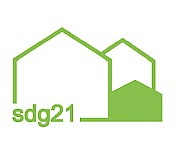- Broad alliance of civil society, science, business and practice demands,
take the entire life cycle of construction into account
- In addition to energy consumption in the use phase, the climate impact must be
of building materials and the construction and disposal of buildings
be considered
- National climate targets can only be achieved if all savings potentials of the
construction sector can be used
 A broad alliance of actors from civil society, science, industry and practice is calling on the German government to promote the climate-friendly construction, maintenance and demolition of buildings. Up to now, only the use phase of buildings has been taken into account in state subsidies for buildings and in the Building Energy Act. There is a complete lack of specifications and consideration of the climate impact of building materials and the construction and disposal of buildings - despite the fact that the construction sector, with its upstream and downstream processes, contributes around 8 percent to German greenhouse gas emissions.
A broad alliance of actors from civil society, science, industry and practice is calling on the German government to promote the climate-friendly construction, maintenance and demolition of buildings. Up to now, only the use phase of buildings has been taken into account in state subsidies for buildings and in the Building Energy Act. There is a complete lack of specifications and consideration of the climate impact of building materials and the construction and disposal of buildings - despite the fact that the construction sector, with its upstream and downstream processes, contributes around 8 percent to German greenhouse gas emissions.
More than 60 supporters have already signed the appeal "Focusing on the entire building life cycle - a key issue for climate protection", which was published today. With the appeal, the Alliance calls for requirements to be placed on the entire life cycle of the building in federal funding for efficient buildings and in the Building Energy Act.
Dr. Ulrich Wischnath, executive director of Bauwende explains, "The importance of upstream and downstream processes in construction is significant. Today, a typical new building has already caused half of its energy consumption and CO2 emissions before it is first used. We can only reduce this environmental impact if the legal requirements for buildings also apply to the construction and building materials.“
Barbara MetzDeputy Federal Executive Director of Deutsche Umwelthilfe adds: "For effective climate protection, we must consider the entire life cycle of buildings. There is great potential for reducing climate gases from construction and building materials - but this is in danger of being wasted due to a lack of specifications. That's why state funding for renovation and construction must also be linked to criteria that guarantee sustainable building all round."
"The faster the framework conditions are set, the faster the implementation will start and the more houses will be built with the improved climate standard. This is not only good for the climate. Sustainable construction methods and materials also conserve resources and reduce further environmental impacts of the construction sector," notes Danny Püschel, energy policy and climate protection officer at NABU.
The signatories of the appeal point out that after more than 30 years of research and more than a decade of practical testing, there are established procedures for an assessment oriented to the life cycle of buildings. The Federal Government must make sustainable building more widespread by launching the "Federal Promotion for Efficient Buildings" at the beginning of the year. The Building Energy Act must also be revised so that it formulates requirements for buildings that relate to their environmental impact over their entire life cycle. Only in this way can the enormous potential for savings in construction and disposal be tackled in a targeted manner.
The Signatories of the call represent a broad spectrum: from building material manufacturers to energy consultant associations and other building professionals to large environmental associations and the Architects for Future.
The appeal is open for signature until the end of January. Afterwards, it will be presented at a public event and discussed with political representatives. If you would like to sign the appeal, please contact wischnath@bauwende.de
Contact
Dr. Ulrich Wischnath, Managing Director, Bauwende
0176 64059904, wischnath@bauwende.de
Constantin Zerger, Head of Energy and Climate Protection, Deutsche Umwelthilfe
0160 433 40 14, zerger@duh.de
Danny Püschel, Energy Policy and Climate Protection Officer
03028 49 84-15 21, Danny.Pueschel@NABU.DE
Keywords:
Building materials / Construction, DE-News, Housing policy, Life cycle assessment




